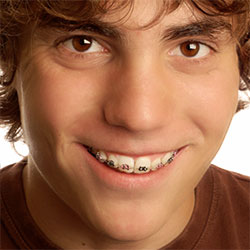Getting and maintaining braces can be a nerve-wracking experience for some people. Knowing exactly what is going to happen and how to handle it is a great way to alleviate some of that anxiety and make sure that you are properly prepared for your new braces. It is important to note that each person will have a slightly different experience, based on their orthodontist and their specific treatment. This experience will also be vastly different for people that opt for Invisalign over traditional braces, as there is less involved in getting the trays than there is in getting brackets and wires. Never fear! We have your complete guide to getting braces.
1. Referral
The first step is getting a referral, usually from a dentist. Because more people visit the dentist on a regular basis than visit an orthodontist on a regular basis, it is usually the dentist who will look at the patient’s teeth and recommend that they see an orthodontist. However, you can always set up your appointment on your own, simply by calling the office and asking to meet with the orthodontist. It may be helpful to bring your latest set of x-rays from your dentist and whatever concerns you have about your teeth.
2. Consultation
Your first meeting with the orthodontist will be the consultation. He will look at your teeth and determine what needs to be done in order to straighten your teeth, or if you would even benefit from an orthodontic treatment. While many people would and do benefit from straighter teeth, there are some situations in which a person’s teeth are straight enough and braces would be an unnecessary expense. The orthodontist will look at your teeth and you x-rays and determine the best plan of action. During this meeting, he may also make a mold of your teeth, in order to better design your treatment.
3. Designing Treatment
After the consultation, the orthodontist will design a treatment that is specific to your needs. Not every person has an underbite or an overbite, and not every person has gaps in their teeth or overcrowding. Each mouth is different and treatment must be specific to the individual in order to work properly. Off of the mold that was taken of your teeth, the orthodontist will create a mockup of the braces.
4. Placing the Braces
This initial appointment will be much longer than any of the future appointments. It involves conditioning the surface of the teeth, to provide a place to cement on the brackets, cementing the brackets in place, and placing the first wire. After a cleaning, the conditioning can take anywhere from ten to thirty minutes. Then, the teeth are primed for the cement, and then the brackets are placed, based on predetermined positions, designed by the orthodontist.
5. Inserting the Wire
Once the brackets are in place, it is time to insert the wire into the brackets. Orthodontists start out with a semicircle of wire, cut it to the right length, and sometimes insert bends or kinks into the wire in order to create leverage over the teeth, which will help them move faster into the correct position. The wire is then placed into the brackets and the doors closed to hold it in place.
6. Discussion of Oral Care
While the orthodontist may go over some of the basis of bracket care during the consultation, he will likely go into depth about how to brush your teeth, what kind of toothpaste to use, and may even provide special tooth brushes in order to make cleaning your teeth and brackets easier. Small spindle brushes are common, which can help to remove food particle and bacteria from around the brackets and in between the wire and your teeth.
7. Adjustments
After the wire has been placed, there is usually a period of three to four weeks before the next adjustment. During an adjustment, the orthodontist removes the wire, bends it again, or inserts a new wire, often using the old wire as a guide. This new wire will be slightly stronger or have a different configuration than the last wire, in order to continue moving the teeth. Each time you go in for an adjustment, the dentist will insert a slightly different wire, to pull or push the teeth in a certain way.
8. Dentist Appointments
During the time you wear braces, it is very important to stay on top of your dentist appointments. Dentists can help keep your teeth clean during a time when it might be very difficult to brush. Brackets and wires make it difficult for you to reach your teeth, but dentists and hygienists have been trained in cleaning around brackets and can provide pointers to help you clean more efficiently and effectively.
9. Dietary Restrictions
Braces will come along with a number of dietary restrictions. These are very important to follow. In general, Dr. Gemmi and Dr. Middleberg will tell you to avoid sticky and crunchy foods, as well as hard fruits like apples. While small pieces of hard food may be alright, anything that requires you to take a large bite into something hard could result in popping off a bracket. While these restrictions may seem unnecessary, they are actually intended to make sure that your braces treatment goes as smoothly and as quickly as possible.
Each person’s treatment will be a little bit different, but the process of getting braces on and caring for them is generally the same. During this time, it is vital that you follow the instructions of Dr. Gemmi and Dr. Middleberg and your dentist, and properly care for your teeth, Braces can improve your oral health, but in order for them to work properly, you must do you part when it comes to cleaning and care.




